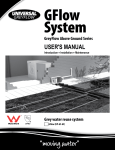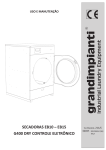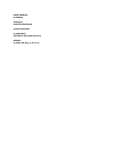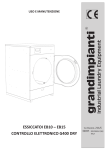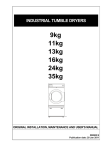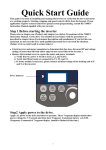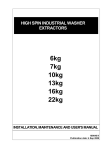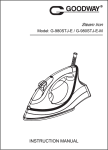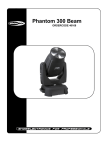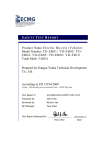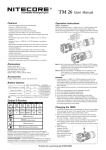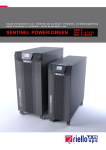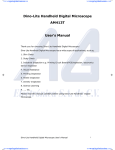Download Scarica - Grandimpianti
Transcript
2010 Functioning Istruzioni diinstructions. funzionamento. Maintenance and cleaning. Manutenzione e pulizia. Manuale EB10-15-25-33-41G400DRY EB10-15-25-33-41G400DRY Manual Realizzato in base alla EN 62079:2002-01 – EN 60204-1 Conservare per futura consultazione. Keep for future consultation. Manufactured on the basis of EN 62079:2002-01 – EN 60204-1 MA_H010_EB10-15-25-33-41_CAP6-7_rev.00 MA_H010_EB10-15-25-33-41_CAP6-7_rev.06.docx 30/03/2010 1 Index 6. FUNCTIONING INSTRUCTIONS.................................................................................... 4 CHEMICAL HAZARD................................................................................................... 4 6.1 FUNCTIONING IN SAFE CONDITIONS........................................................................... 4 6.2 ROUTINE FUNCTIONING (MANUAL, AUTOMATIC FUNCTIONING)...................................... 5 6.2.1 DESCRIPTION OF THE APPLIANCE AND CONTROL PANEL................................................ 5 6.3 DISPLAY DESCRIPTION.............................................................................................. 6 6.4 SELF-SERVICE.......................................................................................................... 7 6.4.1 INSTALLATION OF THE EMERGENCY STOP BUTTON........................................................ 7 6.4.2 SETTING CARD FOR SELF-SERVICE FUNCTIONING......................................................... 7 6.4.3 VERSIONS................................................................................................................ 8 6.4.4 MULTIPLE PAYMENT................................................................................................... 8 6.4.5 DISPLAY INDICATIONS............................................................................................... 8 6.4.6 CYCLE COST SETTING................................................................................................ 9 6.4.7 OPENING AND CLOSING THE DOOR............................................................................10 6.5 RECOMMENDATIONS FOR USING THE APPLIANCE.........................................................11 6.5.1 SYMBOLS (LABEL) APPLIED TO THE FABRICS...............................................................11 6.6 DRYING CYCLE START-UP..........................................................................................13 6.6.1 DRYING CYCLE START...............................................................................................14 6.7 AUTOMATIC EXECUTION OF A PROGRAM.....................................................................15 6.8 DESCRIPTIONS OF THE STANDARD PROGRAMS SUPPLIED WITH THE KG10 AND KG15 APPLIANCE MODELS..............................................................................................................15 6.9 DESCRIPTIONS OF THE STANDARD PROGRAMS SUPPLIED WITH THE KG25, KG33 AND KG41 APPLIANCE MODELS..........................................................................................................17 6.10 SECONDARY FUNCTIONS...........................................................................................20 6.10.1.. INTRODUCTION TO THE PROGRAM...........................................................................20 PROGRAMMING LIMIT FOR G400DRY...................................................................................21 6.11 SYMBOLS OF THE ICONS USED IN OPTIONS AND PROGRAMMING MODIFICATIONS...........21 DISPLAY . ........................................................................................................................21 APPLIANCE SWITCH-ON AND RELATIVE BASIC FUNCTIONS.....................................................21 6.11.1.. MODIFICATIONS AND DISPLAYS DURING THE PERFORMANCE OF A PROGRAM...............23 6.11.2.. APPLIANCE PARAMETERS MENU...............................................................................23 6.11.3.. SERVICE MENU......................................................................................................24 6.11.4.. CYCLE MENU.........................................................................................................24 6.11.5.. TEST CYCLE..........................................................................................................25 6.11.6.. PRESET OPERATION...............................................................................................25 6.12 FUNCTIONS/EXCEPTIONAL SITUATIONS......................................................................25 6.12.1.. ABORT PROGRAM IN THE EVENT OF ANOMALIES.......................................................26 6.13 SIGNS TO OBSERVE..................................................................................................26 6.14 OPTIONAL MODULES, ADDITIONAL.............................................................................26 6.14.1.. QUICK REFERENCE INSTRUCTIONS..........................................................................26 6.14.2.. DISPOSAL OF WASTE.............................................................................................26 USER INFORMATION..........................................................................................................27 7. MAINTENANCE AND CLEANING...................................................................................28 7.1 SAFETY PRECAUTIONS..............................................................................................28 7.2 SAFETY FUNCTIONS WITH WHICH THE APPLIANCE IS SUPPLIED.....................................29 7.3 MAINTENANCE AND CLEANING PERFORMED BY THE USER.............................................29 7.3.1 CALIBRATION OF THE EXTRACTION FUNCTION.............................................................29 HOW TO PROCEED WITH CALIBRATION................................................................................29 7.3.2 DAILY AND WEEKLY CLEANING...................................................................................30 7.3.3 MONTHLY CLEANING.................................................................................................30 7.3.4 DAILY, WEEKLY AND MONTHLY MAINTENANCE AND CLEANING REGISTER........................31 7.4 ROUTINE MAINTENANCE AND CLEANING BY NOTIFIED OR TRAINED PERSONNEL..............31 7.4.1 ROUTINE MAINTENANCE. 750H CONTROL VALID FOR ALL MODELS.................................32 7.4.2 ROUTINE MAINTENANCE. BEARINGS LUBRICATION . ....................................................32 7.4.3 CLEANING THE SUCTION DEVICE FAN, THE FILTER COMPARTMENT AND THE PRESSURE SWITCH PIPES..................................................................................................................33 7.4.4 PREVENTIVE MAINTENANCE.......................................................................................33 7.4.5 ROUTINE MAINTENANCE. SPECIFIC ANNUAL CONTROL FOR GAS MODELS........................34 7.4.6 ROUTINE MAINTENANCE. YEARLY CONTROL VALID FOR ALL MODELS..............................34 7.5 MODULE MAINTENANCE AND CLEANING BY QUALIFIED PERSONNEL...............................35 7.6 TROUBLESHOOTING. DIAGNOSIS AND REPAIRS, DISPLAY MESSAGES.............................36 7.7 ALARMS DESCRIPTION..............................................................................................36 7.8 MANAGEMENT OF THE ALARMS LOG............................................................................41 7.8.1 ATTENTION MESSAGE DISPLAYED...............................................................................41 2 MAINTENANCE MESSAGE....................................................................................................41 ENERGY SAVING SWITCH ME OFF MESSAGE.........................................................................42 PAUSE MESSAGE...............................................................................................................42 DIFFERENT MESSAGES.......................................................................................................42 BLOCK APPLIANCE BETWEEN "XX" CYCLES MESSAGE.............................................................42 POWER FAIL MESSAGE.......................................................................................................42 Translation of the original instructions. For any claims or observations the reference text is the original one in the manufacturer's language i.e. Italian. 3 6.FUNCTIONING INSTRUCTIONS Attention! • Any person using this appliance must read this user manual. • The appliance must only be used by trained persons. • The appliance cannot be used by persons (including children) with reduced physical, sensorial, mental capacities or with little experience or knowledge unless they have been examined or trained regarding the use of the appliance by suitably trained staff that is responsible for his/their safety. • The appliance has not been designed to be used in environments subject to the ATEX Standard, relative to explosive atmospheres. • The appliance cannot handle laundry that has been in contact or soaked in inflammable substances. • The appliance has not been designed to disinfect linen. • Before performing and cleaning or maintenance, make sure that the hot water, cold water and steam cocks are closed (in the appliances with the type of heating) and the master switch is off. • Keep inflammable liquids away from the appliance. • Keep cleaning and soap products away from the appliance and locked in a cabinet. • Children must be controlled so that they do not play with the appliance. CHEMICAL HAZARD Attention! • The appliance cannot handle laundry that has been in contact or soaked in inflammable substances. • The decomposition in appliances heated directly with gas by several chemical products, such as certain solvents used for dry cleaning, can produce toxic fumes. 6.1 FUNCTIONING IN SAFE CONDITIONS Check that the laundry trolleys are lower than the door lower limit. Do not allow the trolleys to strike the door, causing damage. Attention! • To prevent the phenomena of spontaneous combustion, the load of laundry must be removed as soon as the drying cycle has ended. • The laundry must be removed for the same reason if the appliance should stop following a power cut. • The appliances may have residues of aggressive chemical products or decomposed elements after the drying cycle of the laundry load, which can cause damage to the appliance a swell as releasing toxic fumes. • The door must not be used as a support for the laundry. 4 6.2 ROUTINE FUNCTIONING (MANUAL, AUTOMATIC FUNCTIONING) 6.2.1 DESCRIPTION OF THE APPLIANCE AND CONTROL PANEL The figures show the appliances with the main components necessary for functioning as well as the appliance electronic control panel. C B G A = Filter cleaning door. B = Smart card reader (optional). C = Emergency stop button. D = Door. E = Door handle. F = Filter cleaning door handle. G = Control panel. E D F D SELECTION button Graphical DISPLAY ECO button Pulsante MODE button Enter Button MINUS button Figure 1 View of control panel PLUS button 5 6.3 DISPLAY DESCRIPTION Press the MODE button with the cycle in execution: the display changes to the following one and indicates the functional parameters if the drying cycle in progress. Program number Cycle sector, value between A, B and C, towards the end. ECONOMY function deactivated. Half sun = Activated Heating on Instant temperature. Envisioned temperature Name of the drying program Filter clogging symbol. Internal depression value Percentage of filter clogging Current absorbed by the drum motor Press the MODE button to go back to standard display. Press the ENTER button to pass to the display and successive modification of the drying cycle functional parameters. Attention! • These modifications are not saved in the memory and therefore on the successive execution of the drying cycle, this will start as per original program. The screens are as shown below . Use the “+” and “-“ buttons to modify the work temperature as desired. Pass to the next screen using the ENTER button. Use the “+” and “-“ buttons to modify the duration of the drying cycle as desired. Pass to the next screen using the ENTER button. Use the “+” and “-“ buttons to modify the cooling temperature of the drying cycle as desired. Pass to the next screen using the ENTER button. Use the “+” and “-“ buttons to modify the cooling duration of the drying cycle as desired. Pass to the next screen using the ENTER button. Use the “+” and “-“ buttons to modify the rotation speed of the drying cycle as desired. Pass to the next screen using the ENTER button or return to the first screen using the MODE button. 6 6.4 SELF-SERVICE Valid for 10kg, 15kg and 25kg load models. 6.4.1 INSTALLATION OF THE EMERGENCY STOP BUTTON On the basis of the following Standard ISO10472-1: paragraph 5.2 The emergency stop device is facultative on the appliances envisioned for self-service. Attention! • The models set-up for self-service, do not have an emergency stop mounted as per standard and therefore they must be made available in the room where the appliances will be installed; proceed as follows. • There must be sufficient emergency stop device in the room, in a number such that at least one is always at a minimum distance of 2 mt from the appliances. • Each emergency stop device must be positioned at a maximum distance of 8 mt from the areas destined to the operators. • If the device consists in an emergency stop button, this must be positioned at a height between 70 cm and 170 cm above the ground or from the platform destined for the operators. The emergency stop device or devices must be connected to the appliance electric power supply source in a way that on their intervention, they can remove the voltage indistinctly to all appliances present in the room used for self-service. 6.4.2 SETTING CARD FOR SELF-SERVICE FUNCTIONING Using dip switch n°3 the appliance can be enabled to function by means of a mechanical or electronic coin operated device. DS3 APPLIANCE STATUS ON WITH COIN OPERATION OFF WITHOUT COIN OPERATION The “economy” function is not available in the coin operated versions and the ECONOMY button input becomes “rapid advancement”. The START button therefore assumes just the cycle start function. By programming from the push button control panel, set the number of tokens necessary to perform each drying cycle present on the appliance. In order to start the cycle, the board must count just as many activations of the KGETT input (one activation at every token). Drying cycle start then takes place as always using the START key. OFF ON 7 6.4.3 VERSIONS These versions can be present: • • • • • Coin operated Central payment unit Stepper Multiple payment: YES / NO (default NO) N° of payments: 1 – 10 (default 3) 6.4.4 MULTIPLE PAYMENT The activated multiple payment option means that it is possible to pay a maximum of n times with n=10 increasing the machine functioning time. Attention! • The temperature increase only has effect if and only if the successive payment is made during heating. • Payments made during the cooling phase have no more effect on appliance functioning If the temperature maintenance time is equal to“x” minutes for a payment made, if the multiple payment is enabled then at every payment the machine functioning time is increased by one unit. Example By paying 3 times the appliance functions for a period of time equal to 3 times the time “x”, up to a maximum of 10 times the time “x”, depending on how the last parameter “N° of payments” is programmed (see attached block diagram). Over the the maximum number of payments programmed, the functioning time value and excess payments are not increased or memorised. Electronic coin operation prevents the acceptance of excess payments. 6.4.5 DISPLAY INDICATIONS As well as the normal display indications in drying cycle START stand-by condition, the following indications will also be displayed depending on the type of SELF SERVICE setting: Coin operation with stepper Writing displayed, with appliance waiting for payment and before activation of the START button: “Insert n. tokens: xx” External coin operation or central payment unit Writing displayed, with appliance waiting for payment and before activation of the START button: “Make the payment” Electronic coin operation on the machine Writing displayed, with appliance waiting for payment and before activation of the START button: “Make the payment of €:xx.xx” In this version the following message is also given: “the machine does not give change”. 8 6.4.6 CYCLE COST SETTING To set the cost/drying cycle, apply voltage to the appliance with the PRGET contact closed, positioned in the rear of the same. Depending on the type of SELF SERVICE management activated, the following options can be carried out: Coin operation with stepper The display shows the price (n. tokens) of the selected drying cycle with a display such as: Pxx :(program number from 01 to 20) Cycle cost: xx (01-10) using the “PLUS” and “MINUS” buttons, the price can be modified (field 1...10) while using the “SEL” the drying cycle can be modified. All cycles stored in the appliance are proposed, also those that are present but not enabled. External coin operation or central payment unit No price can be programmed because everything is managed with the remote payment system. The appliance is enabled for start-up with just one impulse of at least 200msec coming from the central payment unit. Electronic coin operation on the machine The display shows the price and cycle selected with a display that is: Pxx :(program number from 01 to 20) Cycle cost: xx,xx € Using “PLUS” and “MINUS” the price can be modified (field variable from 0.00€ to 99,95€ with minimum steps of 0.05€) and with “SEL” button, the drying cycle can be modified, to which the sale price can be applied. All cycles stored in the appliance are proposed, also those that are present but not enabled. To end programming, take the PRGET selector to position “0” and remove and re-apply voltage to the appliance. With the coin operation function enabled, switch the appliance on, the display shows: The drying cycle selected with the maximum temperature envisioned. The time programmed for the countdown. “Insert n. tokens: xx” Or“Make the payment” Or“Make the payment of €: xx.xx” Depending on the possible different payment method settings. “xx” and “xx,xx” correspond to the value previously introduced, expressed as a number of tokens or cost in €, for that particular drying cycle. During the insertion of tokens or coins the cost of the drying cycle will reduce until on introduction of the last token/coin, the display indicates “00” flashing The following wording appears with the door closed: “PRESS START” Press the START button to start the drying cycle. 9 With the door open, two different wordings appear: “load the laundry” “close the door” On start-up of the drying cycle, the display shows the normal indications present also on appliances that are not envisioned for self-service. Attention! • The number of tokens or coins already inserted and not used remains memorised if there should be a power cut. • The maximum credit, i.e. the maximum number of tokens counted is 10. • The maximum credit, i.e. the maximum value that can be accumulated is 20.00€. The residual credit can be zeroed with machine in stand-by to start the drying cycle and with the door open, following the procedure illustrated here. This must be concluded within the maximum time of 10 seconds: • Press the ECO key 5 times consecutively; • Press the START key 5 times consecutively; The confirmation of zeroing of any residual credit takes place with the message covering the entire display “CREDIT ZEROED” NOTE The 10 second count starts from the first time the ECO key is pressed. Attention! • Only enabled drying cycles can be carried out; • It is not possible to access programming of optional parameters; • It is not possible to insert a pause during the drying cycle; • In the event of a power cut during a drying cycle, when the voltage returns re-starts only occurs after the START button has been pressed, without having to insert other tokens/coins. • The optional parameters enabled before insertion of P3 remain active even after enabling of coin operation (except for “Cycle delayed start”). 6.4.7 OPENING AND CLOSING THE DOOR Use the handle and pull to open the door. Opposite action to close. The door is not fitted with lock/release devices and can be opened also with the drying cycle in progress. Opening the door with the drying cycle in progress leads to the immediate shutdown of drum rotation and the appearance of the “E2: door open” alarm. Close the door and press the START button to re-start the drying cycle. 10 6.5 RECOMMENDATIONS FOR USING THE APPLIANCE The nominal laundry load is intended as performed with laundry spun with factor G ≥ 400 and % RH≤50. For resistant fabrics such as cotton or linen, the use of the nominal load is recommended, while for delicate-synthetic fabrics, the use of a reduced load is recommended. This allows a less energetic action. Where it is not strictly necessary, it is recommended to carry out cycles with reduced load and heating temperature in order to decrease appliance energy consumption, with consequent reduction of execution times of the cycle itself. Attention! • Do not touch the door glass as it can become very hot when the appliance is functioning. Pay attention to the indication given. 6.5.1 SYMBOLS (LABEL) APPLIED TO THE FABRICS Symbols Basic symbols Washing: the tub is the symbol for washing. Chlorine bleach: the chlorine bleach symbol is a triangle. Ironing: for ironing the symbol is the shape of an iron. Professional textile care. Professional washing. Tumble drying: A square containing a circle is the symbol for tumble drying. Symbols Basic symbols Treatment not allowed: as well as the previous symbols, St. Andrew's cross positioned on the symbol means that the treatment expressed by that particular symbol must not be performed. Moderate treatment: as well as the 5 symbols, the bar under the tub or the circle indicates that the treatment must be carried out moderately with respect to the treatment corresponding to the same symbol without bar. Very moderate treatment: as well as the 5 symbols, the interrupted bar under the tub indicates a very moderate washing treatment. Symbols Additional symbols Maximum temperature: 95°C. Normal machine action. Normal rinse. Normal spin. Maximum temperature: 95°C. Gentle machine action. Cool down rinse (due to gradual introduction of cold water). Short spin. Maximum temperature: 70°C. Normal machine action. Normal rinse. Normal spin 11 Maximum temperature: 60°C. Normal machine action. Normal rinse. Normal spin Maximum temperature: 60°C. Gentle machine action. Cool down rinse (due to gradual introduction of cold water). Short spin Maximum temperature: 50°C. Gentle machine action. Cool down rinse (due to gradual introduction of cold water). Short spin Maximum temperature: 40°C. Gentle machine action. Cool down rinse (due to gradual introduction of cold water). Short spin Maximum temperature: 40°C. Gentle machine action. Normal rinse. Normal spin Do not twist Maximum temperature: 40°C. Gentle machine action. Normal rinse. Short spin Hand wash only. Do not machine wash - maximum temperature 30°C. Handle with care Do not wash. Handle with care when wet. Symbols Tumble drying Tumble drying allowed. Normal drying program Tumble drying allowed. Low temperature drying program Do not tumble dry Symbols Natural Drying Line dry. The article is dried by hanging it WET on a line after having removed the excess water. Drip dry. The garment is hung wet, dripping, with or without re-shaping, without removing any excess water. Dry flat. The garment is re-shaped and dried on a flat surface after the removal of any excess water. Dry in the shade. This symbol is placed at the side of the line drying, drip dry or flat dry symbols to indicate that the process must be performed away from the action of direct sunlight. Symbols Bleaching Chlorine-based bleaching allowed only in a cold and dilute solution. Do not use chlorine bleach. Any oxidising agent bleach allowed. Only oxidising bleach without chlorine allowed. 12 DO NOT bleach. Symbols Ironing Iron at a maximum sole-plate temperature of 200°C. Iron at a maximum sole-plate temperature of 150°C. Iron at a maximum sole-plate temperature of 110°C. Steam ironing may be risky. Do not iron. Steam ironing and treatments are not allowed. Symbols Professional textile care. Dry cleaning in all solvents normally used for dry cleaning including the solvents indicated for P symbol as well as trichloroethylene and 1.1.1. trichloroethane. Dry cleaning with tetrachloroethylene, monofluorotrichloromethane as well as all solvents indicated for F symbol. Normal washing treatments, without restrictions. Dry cleaning using solvents indicated in previous point. Strict limitations on the addition of water and/or mechanical action and/or temperature during cleaning and/or drying. Self-service cleaning is not allowed. Dry cleaning with trifluorotrichloroethane, hydrocarbons (boiling point between 150°C and 200°C, flashpoint between 38°C and 60°C). Normal washing treatments, without restrictions. Dry cleaning using solvents indicated in previous point. Strict limitations on the addition of water and/or mechanical action and/or temperature during cleaning and/or drying. Self-service cleaning is not allowed. Professional washing. Normal procedure. Professional washing. Delicate procedure. Professional washing. Very delicate procedure. Do not dry clean. No stain removal with solvents. 6.6 DRYING CYCLE START-UP Start-up of drying cycle: • Check the drum is empty and clean. • Load the laundry with the same features /type of fabric and the same drying requirements. • Check the labels on every item and follow the indications given. Before drying any garment, make sure that any buttons, zips, clips and buckles face inwards. • Check the pockets: they must be empty. • Open the steam and condensate drain/recovery gate valves (for appliances with this type of heating). • Open the gas gate valves (for appliances with this type of heating). • Power the appliance. Check switch-on of the appliance display. Wait a few seconds for the cycle selection stand-by configuration to appear on the appliance display. • Select the cycle using the SEL button according to that stated on the labels of the garments to dry. • Close the door and press the START/STOP button. 13 See the table below for that amount of laundry to load. Appliance maximum load capacity (wet laundry at 50% RH ) model kg 10 kg 15 kg 25 kg 30 kg 41 The drying cycle starts at this point. 6.6.1 DRYING CYCLE START. Program number Start message with FW-software version and appliance version display Switch-on Drying temperature P 01 90°C Selection ECO Program name Door status Change ECO function Total duration of the program 00:30 Machine ready Change cycle NO YES Door closed? Close the door Program execution P 01 phase in progress When the cycle has finished , the appliance signals program end with an acoustic message and the “CYCLE END” message appears on the display. Attention! • Before opening, always make sure that the drum is at a standstill and that the internal temperature has dropped below 40°C. • Do not put laundry into the machine that has been cleaned, wet, washed or stain-removed with flammable or explosive materials. Proceed by hand washing. End of work: carry out the following operations. • Leave the door open. • Remove the voltage to the appliance via the master switch. • Close the gas, the steam and condensate recovery/drain cocks (on the appliances with this type of heating). • Isolate the appliance from the mains electricity. Attention! • Do not leave the appliance uselessly powered by the mains electricity. • Switch the appliance master switch OFF when the same is not being used. 14 6.7 AUTOMATIC EXECUTION OF A PROGRAM The electronic control is already supplied with some standard drying programs. On pressing the START button, the electronic control performs the phases necessary for the drying cycle selected. The basic drying cycle sequence envisions: • • • • verification phase of any laundry overload; heating phase; drying phase, with set-point temperature maintained; cooling phase. Some phases are not present on all drying cycles! Every phase of which the drying cycle is made up can have a dedicated drum movement and temperature for the type of textile to be handled. 6.8 DESCRIPTIONS OF THE STANDARD PROGRAMS SUPPLIED WITH THE KG10 AND KG15 APPLIANCE MODELS Table A1 A1 Cycle N Cycle name 1 Towels 2 3 4 5 DRYING Cooling Temperature Maintenance Heating Power Time [°C] [min] [%] 160 45 95 Light cotton 140 41 Medium cotton 150 44 Synthetic 80 Delicate 90 6 Normal dynamic 7 Motor Heating Temperature Rh/Lh activation Pause time Speed min. ºC [s] [s] [rpm] 5 30 30 1 46 Standard 95 5 30 30 1 48 Standard 95 5 30 30 1 47 Standard 30 95 3 30 45 1 48 Standard 35 95 3 30 60 1 49 Standard 165 40 95 5 30 30 1 48 Standard Medium dynamic 150 45 95 5 30 30 1 47 Standard 8 Intensive 160 35 95 5 30 25 1 48 Standard 9 Heavy intensive 160 40 95 5 30 25 1 48 Standard 10 Mixed synthetic 90 30 95 3 30 30 1 47 Standard 11 Towels 160 45 95 5 30 30 1 46 Automatic 12 Light cotton 140 41 95 5 30 30 1 48 Automatic 13 Medium cotton 165 44 95 5 30 30 1 47 Automatic 14 Synthetic 80 30 95 3 30 45 1 48 Automatic 15 Delicate 90 35 95 3 30 60 1 49 Automatic 16 Normal dynamic 165 40 95 5 30 30 1 48 Automatic 17 Medium dynamic 150 45 95 5 30 30 1 47 Automatic 18 Intensive 160 35 95 5 30 25 1 48 Automatic 19 Heavy intensive 160 40 95 5 30 25 1 48 Automatic 20 Mixed synthetic 90 30 95 3 30 30 1 47 Automatic 15 Table B1 B1 Cycle N Cycle name DRYING Cooling Motor Heating Temperature Maintenance Heating Power Time Temperature Rh/Lh activation Pause time Speed [°C] [min] [%] min. ºC [s] [s] [rpm] 1 Towels 140 50 95 5 30 30 1 46 Standard 2 Light cotton 140 41 95 5 30 30 1 48 Standard 3 Medium cotton 140 47 95 5 30 30 1 47 Standard 4 Synthetic 80 30 95 3 30 45 1 48 Standard 5 Delicate 90 35 95 3 30 60 1 49 Standard 6 Normal dynamic 145 42 95 5 30 30 1 48 Standard 7 Medium dynamic 142 47 95 5 30 30 1 47 Standard 8 Intensive 140 38 95 5 30 25 1 48 Standard 9 Heavy intensive 140 43 95 5 30 25 1 48 Standard 10 Mixed synthetic 90 30 95 3 30 30 1 47 Standard 11 Towels 140 50 95 5 30 30 1 46 Automatic 12 Light cotton 140 41 95 5 30 30 1 48 Automatic 13 Medium cotton 145 46 95 5 30 30 1 47 Automatic 14 Synthetic 80 30 95 3 30 45 1 48 Automatic 15 Delicate 90 35 95 3 30 60 1 49 Automatic 16 Normal dynamic 145 42 95 5 30 30 1 48 Automatic 17 Medium dynamic 142 47 95 5 30 30 1 47 Automatic 18 Intensive 140 38 95 5 30 25 1 48 Automatic 19 Heavy intensive 140 43 95 5 30 25 1 48 Automatic 20 Mixed synthetic 90 30 95 3 30 30 1 47 Automatic Table C1 C1 Cycle N Cycle name DRYING Cooling Motor Heating Temperature Maintenance Heating Power Time Temperature Rh/Lh activation Pause time Speed [°C] [min] [%] min. ºC [s] [s] [rpm] 1 Heavy Cotton 140 30 95 5 30 30 1 48 Disabled 2 Cotton 125 30 95 5 30 30 1 48 Disabled 3 Towelling 110 30 95 5 30 30 1 46 Disabled 4 Synthetic 100 30 95 3 30 45 1 48 Disabled 5 Delicate 90 30 95 3 30 60 1 48 Disabled 6 Normal dynamic 145 42 95 5 30 30 1 48 Standard Table D1 D1 Cycle N Cycle name DRYING Cooling Motor Heating Temperature Maintenance Heating Power Time Temperature Rh/Lh activation Pause time Speed [°C] [min] [%] min. ºC [s] [s] [rpm] Cotton shirts 100 20 95 5 30 30 1 46 Disabled 2 Wool 60 10 95 5 30 30 1 60 Disabled 3 Merinos 70 27 95 5 30 30 1 60 Disabled 1 4 Outer wear 90 20 95 3 30 45 1 70 Disabled 5 Quilted jackets 120 30 95 3 30 60 1 50 Disabled 6 Windcheaters 130 20 95 5 30 30 1 46 Disabled 16 Table E1 E1 Cycle N Cycle name DRYING Cooling Motor Heating Temperature Maintenance Heating Power Time Temperature Rh/Lh activation Pause time Speed [°C] [min] [%] min. ºC [s] [s] [rpm] automatic 1 Towels & Bathrobes 130 30 95 5 30 30 1 41 Disabled 2 Clothing hand iron 125 22 95 5 30 30 1 41 Disabled 3 Sheets roller iron 125 27 95 5 30 30 1 41 Disabled 4 Synthetic 90 20 95 3 30 45 1 41 Disabled 5 Synthetic delicate 80 25 95 3 30 60 1 41 Disabled 6 Mixed cotton 100% Dry 130 20 95 5 30 30 1 41 Disabled 7 Mixed Heavy 100% Dry 130 30 95 5 30 30 1 41 Disabled 8 Intensive hot 15 min 140 15 95 5 30 25 1 41 Disabled 9 Intensive hot 20 min 140 20 95 5 30 25 1 41 Disabled 10 Test 60 8 95 3 30 30 1 41 Disabled 11 Towels & Bathrobes 130 30 95 5 30 30 1 41 Enabled 12 Clothing hand iron 125 22 95 5 30 30 1 41 Enabled 13 Sheets roller iron 125 27 95 5 30 30 1 41 Enabled 14 Synthetic 90 20 95 3 30 45 1 41 Enabled 15 Synthetic delicate 80 25 95 3 30 60 1 41 Enabled 16 Mixed cotton 100% Dry 130 20 95 5 30 30 1 41 Enabled 17 Mixed Heavy 100% Dry 130 30 95 5 30 30 1 41 Enabled 18 Intensive hot 15 min 140 15 95 5 30 25 1 41 Enabled 19 Intensive hot 20 min 140 20 95 5 30 25 1 41 Enabled 20 Test 60 8 95 3 30 30 1 41 Enabled 6.9 DESCRIPTIONS OF THE STANDARD PROGRAMS SUPPLIED WITH THE KG25, KG33 AND KG41 APPLIANCE MODELS Table A1 A1 Cycle N Cycle name DRYING Cooling Motor Heating Temperature Maintenance Heating Power Time Temperature Rh/Lh activation Pause time Speed [°C] [min] [%] min. ºC [s] [s] [rpm] Towels 160 45 95 5 30 30 1 46 Standard 2 Light cotton 140 41 95 5 30 30 1 48 Standard 3 Medium cotton 150 44 95 5 30 30 1 47 Standard 4 Synthetic 80 30 95 3 30 45 1 48 Standard 5 Delicate 90 35 95 3 30 60 1 49 Standard 6 Normal dynamic 165 40 95 5 30 30 1 48 Standard 7 Medium dynamic 150 45 95 5 30 30 1 47 Standard 8 Intensive 160 35 95 5 30 25 1 48 Standard 9 Heavy intensive 160 40 95 5 30 25 1 48 Standard 10 Mixed synthetic 90 30 95 3 30 30 1 47 Standard 11 Towels 160 45 95 5 30 30 1 46 Automatic 1 17 12 Light cotton 140 41 95 5 30 30 1 48 Automatic 13 Medium cotton 165 44 95 5 30 30 1 47 Automatic 14 Synthetic 80 30 95 3 30 45 1 48 Automatic 15 Delicate 90 35 95 3 30 60 1 49 Automatic 16 Normal dynamic 165 40 95 5 30 30 1 48 Automatic 17 Medium dynamic 150 45 95 5 30 30 1 47 Automatic 18 Intensive 160 35 95 5 30 25 1 48 Automatic 19 Heavy intensive 160 40 95 5 30 25 1 48 Automatic 20 Mixed synthetic 90 30 95 3 30 30 1 47 Automatic Table B1 B1 Cycle N Cycle name 1 Towels 2 3 4 5 DRYING Cooling Temperature Maintenance Heating Power Time [°C] [min] [%] 140 50 95 Light cotton 140 41 Medium cotton 140 47 Synthetic 80 Delicate 90 6 Normal dynamic 7 Medium dynamic 8 9 10 11 Motor Heating Temperature Rh/Lh activation Pause time Speed min. ºC [s] [s] [rpm] 5 30 30 1 46 Standard 95 5 30 30 1 48 Standard 95 5 30 30 1 47 Standard 30 95 3 30 45 1 48 Standard 35 95 3 30 60 1 49 Standard 145 42 95 5 30 30 1 48 Standard 142 47 95 5 30 30 1 47 Standard Intensive 140 38 95 5 30 25 1 48 Standard Heavy intensive 140 43 95 5 30 25 1 48 Standard Mixed synthetic 90 30 95 3 30 30 1 47 Standard Towels 140 50 95 5 30 30 1 46 Automatic 12 Light cotton 140 41 95 5 30 30 1 48 Automatic 13 Medium cotton 145 46 95 5 30 30 1 47 Automatic 14 Synthetic 80 30 95 3 30 45 1 48 Automatic 15 Delicate 90 35 95 3 30 60 1 49 Automatic 16 Normal dynamic 145 42 95 5 30 30 1 48 Automatic 17 Medium dynamic 142 47 95 5 30 30 1 47 Automatic 18 Intensive 140 38 95 5 30 25 1 48 Automatic 19 Heavy intensive 140 43 95 5 30 25 1 48 Automatic 20 Mixed synthetic 90 30 95 3 30 30 1 47 Automatic Temperature Maintenance Heating Power Time Temperature Rh/Lh activation Pause time Speed automatic [°C] [min] [%] min. ºC [s] [s] [rpm] Table C1 C1 Cycle N Cycle name DRYING Cooling Motor Heating 1 Heavy Cotton 140 30 95 5 30 30 1 48 Disabled 2 Cotton 125 30 95 5 30 30 1 48 Disabled 3 Towelling 110 30 95 5 30 30 1 46 Disabled 4 Synthetic 100 30 95 3 30 45 1 48 Disabled 5 Delicate 90 30 95 3 30 60 1 48 Disabled 18 Table D1 D1 Cycle N Cycle name DRYING Cooling Motor Heating Temperature Maintenance Heating Power Time Temperature Rh/Lh activation Pause time Speed [°C] [min] [%] min. ºC [s] [s] [rpm] automatic 1 Cotton shirts 100 20 95 5 30 30 1 46 Disabled 2 Wool 60 10 95 5 30 30 1 60 Disabled 3 Merinos 70 27 95 5 30 30 1 60 Disabled 4 Outer wear 90 20 95 3 30 45 1 70 Disabled 5 Quilted jackets 120 30 95 3 30 60 1 50 Disabled 6 Windcheaters 130 20 95 5 30 30 1 46 Disabled Table E1 E1 Cycle N Cycle name 1 Towels & Bathrobes 2 3 DRYING Cooling Temperature Maintenance Heating Power Time [°C] [min] [%] 130 30 95 Clothing hand iron 125 22 Sheets roller iron 125 27 4 Synthetic 90 5 Synthetic delicate 80 6 Mixed cotton 100% Dry 7 Motor Heating Temperature Rh/Lh activation Pause time Speed min. ºC [s] [s] [rpm] 5 30 30 1 41 Disabled 95 5 30 30 1 41 Disabled 95 5 30 30 1 41 Disabled 20 95 3 30 45 1 41 Disabled 25 95 3 30 60 1 41 Disabled 130 20 95 5 30 30 1 41 Disabled Mixed Heavy 100% Dry 130 30 95 5 30 30 1 41 Disabled 8 Intensive hot 15 min 140 15 95 5 30 25 1 41 Disabled 9 Intensive hot 20 min 140 20 95 5 30 25 1 41 Disabled 10 Test 60 8 95 3 30 30 1 41 Disabled 11 Towels & Bathrobes 130 30 95 5 30 30 1 41 Enabled 12 Clothing hand iron 125 22 95 5 30 30 1 41 Enabled 13 Sheets roller iron 125 27 95 5 30 30 1 41 Enabled 14 Synthetic 90 20 95 3 30 45 1 41 Enabled 15 Synthetic delicate 80 25 95 3 30 60 1 41 Enabled 16 Mixed cotton 100% Dry 130 20 95 5 30 30 1 41 Enabled 17 Mixed Heavy 100% Dry 130 30 95 5 30 30 1 41 Enabled 18 Intensive hot 15 min 140 15 95 5 30 25 1 41 Enabled 19 Intensive hot 20 min 140 20 95 5 30 25 1 41 Enabled 20 Test 60 8 95 3 30 30 1 41 Enabled 19 automatic Attention! • If the appliance has been re-programmed from the keyboard or several special functions have been activated, do not refer to the tables. • The manufacturer reserves the right to modify the drying cycles normally memorised in the machines at any time. 6.10 SECONDARY FUNCTIONS To change the temperature, times, rotation speed and any other drying cycle functional parameters, it is possible to operate in the ways described: • Operate on the keyboard as described in the technical attachment that gives the block diagram of all functions accessible to the user. • Have a smart card programmed with the necessary modifications. Attention! • The smart card reader is optional in this type of appliance. • Do not read or program the appliance if you are not in possession of the appropriate cable and software for the PC: the operation could damage the circuit boards. • Contact the dealer or the after-sales service if appliance programming must be modified. Cables, software and instructions will be supplied in order to make the modifications requested. In the appliances that have a smart card reader, it is possible: • To update the control electronics firmware with 128kB smart card. • To modify programs and parameters (software) with 16kB smart card. If you are interested, contact the dealer or after-sales service and supply details regarding the necessary modifications. The smart card will be sent with the relative instructions for use. Attention! • Do not try to read or program the appliance using the smart cards that are different to the original ones (cash card, credit card, video hire card etc.) as it would be damaged irreparably. The manufacturer is NOT liable for incorrect and improper use of the smart card reader present in the appliance. 6.10.1 INTRODUCTION TO THE PROGRAM During the execution of the drying cycle, it is possible to display some information regarding the phase in progress and several parameters can be changed (on conclusion of the phase, all modified parameters will go back to their original value) while the options or data of the individual phases can be modified only with appliances in stand-by for cycle start. The parameters modified in this way will remain as such until new modification. Also be removing and re-applying voltage to the appliance, this will maintain the programming of the parameters performed. The structure of the drying cycles is defined by the manufacturer on the basis of most market requests However it is possible to change the data of the individual functions with the manual. 20 PROGRAMMING LIMIT FOR G400DRY 35 drying cycles. 6.11SYMBOLS OF THE ICONS USED IN OPTIONS AND PROGRAMMING MODIFICATIONS Symbol Name Description START/STOP Cycle start button, forced advancement button of the drying cycle and cycle end. Used in the “comments” text to delete the character selected. MODE Button used to enter and escape the menu address, escape without confirming variations or display information during execution of the program. ECO Button for reducing the temperature maintenance hysteresis for the drying cycle selected and the draining temperature. MINUS Button used to change item in the menu, decrease the value displayed, shift to the left in the texts or comments. PLUS Button used to change item in the menu, decrease the value displayed, shift to the right in the texts or comments. ENTER Button used to confirm the value displayed, enter the menu item displayed or confirm the character to be modified. SEL Button used to select the program or select the letters (if texts, comments or maintenance technician name are inserted). DISPLAY The background colours used in this manual are only to help to understand the part of the menu in progress. The display on the appliance is always green with the text, icons and all parameters in black. Attention! • If voltage should be missing during the modify MACHINE, SERVICE, CYCLES, PHASES PARAMETERS, the data is not stored and the procedure must be repeated from the start. APPLIANCE SWITCH-ON AND RELATIVE BASIC FUNCTIONS A beep is heard every time the button is pressed. At the end of the drying cycle the appliance emits a sequence of beeps for 15 seconds. This sequence can be interrupted by pressing the “ – “ button. it is also possible to completely eliminate buzzer functioning if it is not necessary. Set on the relative BUZZER item in the MACHINE PARAMETERS menu. 21 Below find the basic structure of the various programming menus. Possibility for preset (see instructions point Z page 26 ), programming with PC or smart card (see specific instructions) Program number P 01 90°C Start message with FW-software version and appliance version display Switch-on Insert technicians name using the SEL, + and – and Enter keys Total duration of the program 00:30 Program name Door status MAINTENANCE Cycles Washing temperature Selection ECO 0/0750 Cycles reset confirmation appears for a few seconds MAINTENANCE Change ECO function Change cycle Technician: MAINTENANCE MAINTENANCE Time Day 0/0750 Machine ready Select day month and year using + and – keys and confirm with enter dd/mm/yy Hold down for 8” YES Door closed? Programming NO TRACK DATA Programming CYCLE 01 10 times in 15” Towels Programming SERVICE Programming MACHINE PAR. FOR COOL CALIBRATIONS Programming Close the door MACHINE PAR. FOR Close the door Service ENTER PASSWORD Programming PHASES MACHINE PAR. FOR CALIBRATIONS Door closed Program execution P 01 phase in progress MACHINE PAR. FOR Execution of calibration CALIBRATIONS 22 P 01 90°C Program name Door status 00:30 Attention! ECONOMY function • This function reduces the heating hysteresis and also the discharge temperature in the appliances with double probe. It is not to be intended as the “½ load button”. 6.11.1 MODIFICATIONS AND DISPLAYS DURING THE PERFORMANCE OF A PROGRAM It is possible to change some functions during the execution of the program, such as: • • • • • Temperature maintenance time Maximum drying temperature. Cooling time Cooling temperature Drum rotation speed. Proceed as follows. • Pressing the MODE button during the execution of the drying cycle. • The display indicates the current work conditions such as: • Real and set temperature (only the value of T1 in the models from 10kg and 15kg and T1-T2 in the models from 25, 33 and 41kg load). • Percentage of filter clogging. • Current absorbed by the motors. Press the ENTER button to pass to the display of the various parameters that can be managed with the cycle in progress. The passage from one parameter to another takes place using the ENTER while codification of the values takes place using the PLUS and MAIN buttons. Attention! • All variations made in this way are stored and at the end of the drying cycle, the settings go back to the initial ones. 6.11.2 APPLIANCE PARAMETERS MENU With door open and pressing the MODE button, enter the programming of the PARAMETERS” menu optionals. From this menu it is possible to: “MACHINE • Hide cooling (if envisioned in the cycle sequence) • Perform a delayed start-up (enable the function and time desired). On exiting programming, • • • • • on pressing the start button, the countdown will begin. This function must be reset every time it has to be activated. Disable the buzzer. Cycles can be enabled (in the event of disabling they will be hidden not deleted) that therefore will not be displayed by pressing the SEL button Change the heating hysteresis. Set the drying cycle temperature to be displayed as dummy, real or set. Set fixed drying cycle execution display in self-learning or real mode. 23 6.11.3 SERVICE MENU Press the MODE button with door open and then press the Plus button to display the “SERVICE menu. In this menu it is possible: • • • • • • • • • To set the functioning language. Change the unit of measurement of the temperature (degrees Centigrade or Fahrenheit). Change the password 1 and 2. Display the appliance log, such as electric and gas consumption divided by totals and last drying cycle performed. Set the start message (“large” comment is displayed in the top part of the display on ignition, “small” in the lower part, both with maximum of 16 characters). Verify the block status of the appliance. Test all appliance functions. Set the economy button action percentage button (ECO). Check the last 10 alarms occurring, with indication of the drying cycle and the phase when the event took place. The other parameters of the menu addresses require a different password to be displayed (password 2). This is only available for the technicians of the manufacturer and it is not generally necessary in the event of technical assistance. 6.11.4 CYCLE MENU The drying cycles are set in this menu depending on the requirements of the textile to be handled , whenever none of the 20 cycles envisioned by the appliance manufacturer responds to the request. Drying cycles menu. Select the drying cycle whose settings must be changed. Menu items Comment All of the selections are made by modifying the value using the “+” and “-“ buttons, confirming with “ENTER”. To go back, use “MODE”. Values allowed Introduction of the cycle name depending on requirements. Heat Menu Cool Menu Finishing Menu Menu items Values allowed Temperature • • Maintenance 1 ÷ 90min Heating power 70 ÷ 100% Values set: 100% gas and steam heating 95% electric heating Heat pump Yes/no Control • • Menu items Values allowed Temperature -- ÷ 100°C Time -- ÷ 10min Menu items Values allowed Time Menu items Humidity Menu Motor Menu Probe T2 Humidity Probe -- ÷ 60sec Values allowed Delta T2 Value --°C RH percentage Value --% Timeout Value (minutes) Menu items Values allowed Rh/Lh activation 30 ÷ 180sec Pause 30 ÷ 30sec • • 24 0 ÷ 140°C (10-15kg) 0 ÷ 165°C (25-33-41kg) 20 ÷ 80rpm (10-15kg) 20 ÷ 65rpm (25-33-41kg) 6.11.5 TEST CYCLE The appliance electronics envision a TEST cycle in order to verify all functions available during a drying program. Carry out the instructions given in this paragraph and in the attached flow diagram for start-up and management of the test cycle. Attention! • Carry out the test cycle always with drum empty. • The “test cycle” IS NOT a drying cycle and as a unique purpose of checking correct appliance functioning. 6.11.6 PRESET OPERATION Attention! • If the preset procedure is performed incorrectly, faults and malfunctioning can be caused. • Only select the options really present on the appliance, subject of the preset data. • If the data preset procedure is performed incorrectly it can be repeated without damaging the circuit board. • If the data preset procedure has not been performed correctly, DO NOT try to start a drying cycle. For example, selecting the appliance with heating source different to that really present. • It must be performed by qualified personnel and scrupulously following the instructions given. • Eliminate all modifications and any special programs carried out or requested. Restore the standard values and programs. • Do not delete the alarms log, the hours worked and the n° of drying cycles performed. To start the preset procedure, apply voltage to the appliance using the PLUS or MINUS buttons pressed at the same time and follow the instructions on the video. 6.12FUNCTIONS/EXCEPTIONAL SITUATIONS In the event of a power cut during the execution of a program, the appliance stops in safety until the power supply is restored. Attention! • The temperature inside the drum will rise for the first minutes following the power cut. When the power supply voltage returns the appliance performs countdown and “power fail” appears on the display. At the end of the countdown the appliance displays the “START ?” message. Press the START/STOP button to re-start. The drying cycle re-starts from the beginning of the phase in which the power cut occurred. If the door is open when the voltage returns, the cycle considers itself finished. During the functioning of the appliance the functioning conditions are monitored constantly with the indication of an alarm code if an anomaly is detected. The code is “E” followed by a number on the display. If the cause that generated the anomaly signal persists, on appliance switch-on or program re-start, (the operator must press the START/STOP button again) the anomaly will be indicated again. 25 6.12.1 ABORT PROGRAM IN THE EVENT OF ANOMALIES Attention! • The alarms generated by motor management and the inverter, request a long time in order to be reset. • Wait at least 5 minutes before re-starting the appliance. After 5 minutes, power the appliance again via mains voltage. 6.13SIGNS TO OBSERVE Different messages or icons can appear on the display. For the identification of these, refer to the points highlighted successively. 6.14OPTIONAL MODULES, ADDITIONAL The following optional modules can be requested for the appliances, which increase the performance of the appliance in terms of control versatility: • • • • • • • • Automatic extraction kit (only 25kg, 33kg and 41kg). T2 temperature probe in the 10kg and 15kg load models. Humidity detection probe. Smart card reader. Datatrack Device. Fire-prevention system (only 25kg, 33kg and 41kg). Dispenser of non-inflammable perfumed substance. Right or left door leaf. 6.14.1 QUICK REFERENCE INSTRUCTIONS Refer to the flow diagram attached to this manual for the execution of a program. 6.14.2 DISPOSAL OF WASTE When the appliance is no longer to be used, it must be made non-operational, eliminating the materials and keeping that already stated in the paragraph “ 11 Putting the product out of service” in mind. In compliance with the Standards regarding disposal of waste that are in force in the individual countries and for respect of the environment in which the appliance is installed, all appliance parts must be divided in a way that they can be disposed of separately or appropriately recovered. All parts making up the appliance are assimilable to solid urban waste with exception of metal parts, which however, are not listed among special waste in most European countries. 26 USER INFORMATION For the purpose and effects of Directives 2002/95/CE, 2002/96/CE and 2003/108/CE, relative to the reduction of use of dangerous substances in electric and electronic appliances, as well as the disposal of waste” the crossed-bin symbol on the appliance (see figure 49) indicates that the product must be collected separately from other waste at the end of its useful life. The separate collection of this appliance at the end of its life is organised and managed by the manufacturer. If a new appliance is purchased, the user that wants to dispose of this appliance must therefore contact the manufacturer and follow the system Figure 2 that the latter uses to allow separate collection of the appliance at the end of its life. The adequate separate collection for the successive start-up of the appliance to be re-cycled, treatment and environmentally compatible disposal contributes to preventing possible negative effects on the environment and favours the re-cycling of materials that make up the appliance. Abusive disposal of the product by the user leads to the application of administrative sanctions envisioned by the Standards in force. Attention! • When the appliance is put out of service, remember to remove dismantle the door!. Refer to the WEEE European Directive regarding the recovery of parts (only for countries that are part of the European Community). If it possible to dismantle the individual parts and take them to a differentiated collection centre, refer to the cataloguing groups of the individual parts. Ifrequired, the cataloguing groups can be found in the website: www.euwas.org 27 7.MAINTENANCE AND CLEANING Maintenance is divided into five different levels: • Corrective or necessary maintenance Call-out intervention due to fault or sudden malfunctioning. • Routine maintenance It has the purpose of preserving the efficiency and safety of the appliance. • Preventive maintenance Intervene on the appliance in advance to prevent faults or malfunctioning on the basis of the manufacturer's experience. • Improval maintenance Generally, adaptation for improving the protection rating of the appliance or adaptation to the amended Standards in force. • Extraordinary maintenance All important modernisation interventions aimed at prolonging the life span of the appliance or the efficiency of the same, without modifying the functional features and the structure of the appliance. The first three types of maintenance must be considered normal activities, which an appliance may and should undergo. In the last two types of maintenance instead, significant variations can be made to appliance functionality. Repercussions occur at a Standards and legislative point of view, which must be taken into consideration. Any improvement or extraordinary maintenance must be performed by authorised after-sales centres or by duly trained personnel. All maintenance interventions not included in this manual exclude all liability of the manufacturer, which considers itself foreign to any possible repercussion of a legal character. 7.1 SAFETY PRECAUTIONS All appliances must undergo regular technical maintenance and any defects detected, which can jeopardise health and safety of the workers, must be eliminated immediately. Attention! • Before any maintenance operation, remove the voltage to the appliance and isolate all other power sources such as steam/ condensate drain or gas. • Check the drum is at a standstill. • Check that the internal temperature is below 40°C. All personnel interested by the maintenance operations and repairs of the appliance must be qualified specifically to perform these tasks. The personnel assigned to maintenance of the appliances at any of the 5 levels envisioned, must be in possession of all the information necessary for the correct performance of the task assigned. This manual supplies an important part of the information as well as the specific instructions supplied with the new component that replaces the equivalent faulty element. Pay attention to all signals and follow all specific requests from the suppliers of the products necessary for cleaning and maintenance of the appliance. Read the instructions attached to these products and comply with the indications relative to the individual protection devices. 28 7.2 SAFETY FUNCTIONS WITH WHICH THE APPLIANCE IS SUPPLIED Attention! • The appliance is supplied with the safety devices listed below. • Door closed detection micro switch. • Heating resistance protected by fuses. The electric power supply is cut-off in the event of an anomaly. • Emergency stop. Allows to interrupt the cycle in the event of an emergency. • Depression sensor in the air circuit (pressure switch in 25kg, 33kg and 41kg load models): does not enable heating in the presence of insufficient depression. • Safety thermostat. They control the temperature of the air in the circuit in many points of the appliance. • Drum and extraction motor inverter (optional). Regulates motor speed, checks an protects the motor and itself from malfunctioning, such as: excessive temperatures of the circuits or heat dissipators, overcurrents, short circuits, etc.). • Overload sensor. It is an electronic system that can determine whether the drum has been overloaded with laundry by an excessive number of kg. • Flame presence sensor: present only in models with gas heating. 7.3 MAINTENANCE AND CLEANING PERFORMED BY THE USER 7.3.1 CALIBRATION OF THE EXTRACTION FUNCTION Attention! • Operation to be performed with appliance completely unloaded. • Operation to be performed only with fluff filter perfectly clean. • Operation to perform only with evacuation pipe assembled and realised according to the indications present in this manual. • Valid for all models and versions. Always perform on appliance commissioning. • A calibration operation performed incorrectly (with drum not completely empty for example) compromises the performance of the appliance, both in terms of drying and consumption until the successive calibration. • Failure to calibrate can block the use of the appliance with incorrect anomaly signals. • Continuing with use without performing calibration quickly deteriorates the performance of the appliance in terms of drying quality and energy consumption. HOW TO PROCEED WITH CALIBRATION Press the START button 10 times with the door open. The display will show: CALIBRATIONS - “close the door” Close the door (door closed appears) and press the START button. On conclusion the display will show the " System Delta in cm" value. Make note of the value in the appliance inspection report for future maintenance operations. The operation concludes automatically after a few seconds. Attention! • Continuous intervention of the E7 alarm means that the evacuation channel must be modified. 29 7.3.2 DAILY AND WEEKLY CLEANING • Keep the door gasket clean. Do not use acid solvents or greases to clean the gaskets! • Clean the filter compartment every day and at the start of every shift. The display indicates when and how much the filter is clogged. • In 25kg, 33kg and 41kg models with steam heating,clean the inlet filter at least once every week. Air filter for the steam coil. Cooling fan. Attention! • Do not start the appliance with this device inserted. • The internal part of the filter housing is very hot even after the appliance has ended the drying cycle. Do not introduce limbs or tools. • Extract the filter wearing suitable heat protection, such as heat-resistant and isolating gloves. • Failure to clean the filter leads to rapid deterioration of appliance performance. 7.3.3 MONTHLY CLEANING Clean the cover panels with a damp cloth. Do not use inflammable or abrasive products. Attention! • Always keep the forced cooling apertures free from dust (cooling fans) realised in the rear of the appliance. • Do not access with limbs or tools. • Clean the display surface and control panels in general using a slightly damp cloth. Solvents and/or abrasive substances irreparably damage these surfaces. • Do not exert to much pressure. • If body parts should come into contact with the liquid leaking from a damaged display unit, wash using soap and water. • In the event of accidental ingestion of the fluid escaping from the damaged display glass, consult a doctor. Toxicity of the product is very low but care must always be taken. • Never use direct jets of water to clean the appliance. 30 The formation of condensate on the display glass can irreparably damage the display. Even if machine start-up is not envisioned, any drops of water must be dried immediately. Similarly to all electronic components, the display is sensitive to electrostatic discharges. When use of the appliance has been concluded, switch it off, isolate it from the power supply sources and leave the door open. 7.3.4 DAILY, WEEKLY AND MONTHLY MAINTENANCE AND CLEANING REGISTER Below find an example of how a routine maintenance register can be structured (type 2) to accompany the appliance. Starting the appliance OK KO Activity Date Signature Note Date Signature Note Power the appliance with the power supply sources required. Clean the filter and filter compartment at the drain. Record any functioning anomalies. End of the day OK KO Activity Isolate the electric power supply. Isolate any other power supply sources. Clean the contact area of the door gasket. Check drum is empty and clean. Leave the door open. Record any functioning anomalies. 7.4 ROUTINE MAINTENANCE AND CLEANING BY NOTIFIED OR TRAINED PERSONNEL Attention! • Respect that stated in paragraph 2.1 relative to safety. • Even if the isolator switch is in the off position, the input clamps can be powered and are therefore live! • In the event of interventions on the motor or on the inverter (speed regulator), wait 5 minutes from switchoff of the isolating switch in a way that the residual voltage in the inverter has been discharged. If necessary, check that the voltage is lower than 10 Dc on the “+” and “–” terminal board clamps. • Never exclude the safety devices for any reason. Only use original spare parts and if in doubt, consult our technical dept. as soon as possible, stating the model and serial number that can be found on the plate positioned on the rear of the appliance. 31 7.4.1 ROUTINE MAINTENANCE. 750H CONTROL VALID FOR ALL MODELS Check the following every 750 functioning hours: • Check that the drying cycle does not start with the door open and that drum rotation stops if the door is opened during the drying cycle. • Check that the drying cycle does not start with the filter inspection panel open and that drum rotation stops with drying cycle in progress if the panel is opened. • Check that the steam supply filter is clean (in appliances with this type of heating). • Clean/remove all traces of dust accumulated inside and/or outside of the appliance. Attention! • Dust can be a fire hazard. 7.4.2 ROUTINE MAINTENANCE. BEARINGS LUBRICATION Lithium-based lubricant grease must be introduced into the 2 greasing points positioned on the two bearing-supports for all appliances along with additives for high temperatures (NLGI 2) Figure 3 Position bearing greasing attachments. Close the shaft setscrew in the front and rear bearings. Attention! • The grease is only used to lubricate the front and rear bearings. • Excessive lubrication can be just as damaging as poor lubrication. • A grease thrust speed that is to high can deform the bearing sealing screen and jeopardise functioning. • Never use petrol-based lubricants with silicone-based lubricants. • Re-mount the upper rear panel, which was previously removed in order to reach the bearing supports. 32 The appliance automatically signals the request for greasing at the start of the next cycle on reaching 750 hours of functioning. The grease introduced cannot reach areas of the appliance where the laundry is normally loaded. Introduce the grease slowly. To have an indication regarding the grease loading time, consider that every grease gun run must not last more than 12 seconds. The amount of grease to introduce on the request for maintenance must be 2cm3for each greasing connection (rear bearing, front bearing). If the type of grease used is different from that indicated, check that the 2 types of grease are compatible. Lithium-based lubricants re compatible with calcium-based lubricants but not sodium-based. Once lubrication has been performed, the message can be cancelled by zeroing the counter, following the zeroing procedure requested. See attached block diagram. Check for any oil leaks from the reducer. Clean the oil leakage and contact the technical aftersales service. 7.4.3 CLEANING THE SUCTION DEVICE FAN, THE FILTER COMPARTMENT AND THE PRESSURE SWITCH PIPES. Clean the fan fins every 750 hours. Access the fan as follows: 1) 2) 3) 4) 5) 6) Isolate the power supply sources of the appliance. Open the filter inspection panel. Remove the filtering mesh. Use a suction device to clean the filter compartment. Clean the extractor fan using a suction device. Clean the pressure transducer pipes/ electronic and electro-mechanical pressure switch. 3 2 4 5 7.4.4 PREVENTIVE MAINTENANCE Replace the door micro switches and filter door micro switches every 4000 hours using original spare parts only. 33 7.4.5 ROUTINE MAINTENANCE. SPECIFIC ANNUAL CONTROL FOR GAS MODELS Check the gas ignition electrodes and, if necessary, clean them or replace them if worn. There must be 5 mm between them and the burner body. To access the burner box, remove the upper rear panel (A) and then the closure panel (B) of the box itself. At this point, the ignition electrodes (C) ad the flame presence probe (D) are visible and can be serviced. A A D C 7.4.6 ROUTINE MAINTENANCE. YEARLY CONTROL VALID FOR ALL MODELS. Carry out the following controls and checks during the first year of activity: • Make note of the number of cycles performed and state it on the maintenance form. • Check the correct functioning of the differential switch (where envisioned by the type of installation) by pressing the test button. • He the coolest tightness of the electric power connection screws on all components of the electrical equipment. • Check resistances functioning and remove any threads. 34 7.5 MODULE MAINTENANCE AND CLEANING BY QUALIFIED PERSONNEL Installation OK KO Activity Date Signature Note Check the plate data. Check the power supply voltage. Level the appliance. Connection of the power sources Check leaks from the power supply source connection pipes. Gas pressure regulation (models with this type of heating). Check functioning of differential device. Check cycle start only with door closed. Check power supply sources isolating devices. Calibrate the pressure switch. Check first cycle with laundry. Check first cycle with laundry 1st Maintenance every 750 hours, not to be performed over ___________ cycles performed from installation Check cycle start only with door closed. Check filters are clean. Clean filter compartment and suction device fan. Check cleanliness of the forced ventilation areas. Bearings lubrication. Tighten fixing screws of heating remote control switch. Clean drain channels/flues Calibration (only with channels/flue cleaning performed) Carry out the test cycle (press the button + 10 in maximum of 15 seconds) N° of cycles really carried out 2nd Maintenance every 750 hours, not to be performed over ___________ cycles performed from installation Check cycle start only with door closed. Check filters are clean. Clean filter compartment and suction device fan. Check cleanliness of the forced ventilation areas. Bearings lubrication. Tighten fixing screws of heating remote control switch. Clean drain channels/flues Calibration (only with channels/flue cleaning performed) Carry out the test cycle (press the button + 10 in maximum of 15 seconds) N° of cycles really carried out 3rd Maintenance every 750 hours, not to be performed over ___________ cycles performed from installation Check cycle start only with door closed. Check filters are clean. Clean filter compartment and suction device fan. Check cleanliness of the forced ventilation areas. Bearings lubrication. Tighten fixing screws of heating remote control switch. Clean drain channels/flues Calibration (only with channels/flue cleaning performed) Carry out the test cycle (press the button + 10 in maximum of 15 seconds) N° of cycles really carried out 35 7.6 TROUBLESHOOTING. DIAGNOSIS AND REPAIRS, DISPLAY MESSAGES In the event of various anomalies, power cut on over-heating, the appliance signals this by various types of alarms that will be seen on the DISPLAY on the front panel. All details are described in the following paragraphs called ALARMS DESCRIPTION and DISPLAY MESSAGES. The appliance can store the last 10 alarms that have occurred. To display these alarms, enter the SERVICE menu and go to the ALARMS LOG item. For more detailed references, consult the block diagram attached. Attention! • If a component not available is to be replaced, padlock the isolating switch in the off position. • Place a sign on the appliance stating “APPLIANCE OUT OF SERVICE, DO NOT USE” and re-position all previously remove panels. 7.7 ALARMS DESCRIPTION The display of any alarm on the display always remains on. In the event of anomalies that can jeopardise the safety of the operator or the integrity of the components making up the appliance, all activities that the appliance was performing will be stopped on immediate activation of the buzzer. ALARM E1 EXTRACTION MOTOR CIRCUIT BREAKER DESCRIPTION ON DISPLAY E1: extraction motor overload CAUSE There has been over-heating/overloading or a short circuit of the extraction motor. BUZZER ACTIVATION The activation of the BUZZER is envisioned immediately. ALARM RESET The alarm is removed by switching the machine off and back on again. WHAT TO CONTROL Motor cooling fan. Extractor rotor. Presence of the three power supply phases in the three-phase version. Check the motor - fan power supply cable and the correct functioning of the remote control. CORRECTIVE ACTION Cleaning and control of the motor cooling fan. Cleaning and control of the fan impeller: the system must turn very easily by hand. ALARM E1 AUTOMATIC EXTRACTION MOTOR CIRCUIT BREAKER DESCRIPTION ON DISPLAY E1: “Alarm code as per table for E0” CAUSE There has been over-heating/overloading or a short circuit of the extraction motor or inverter 2, which manages it. BUZZER ACTIVATION The activation of the BUZZER is envisioned immediately. ALARM RESET The alarm is removed by switching the machine off and back on again. WHAT TO CONTROL Motor cooling fan. Extractor rotor. Connection of the serial communication cable between the inverter and the G400DRY control. CORRECTIVE ACTION Cleaning and control of the motor cooling fan. Cleaning and control of the fan impeller: the system must turn very easily by hand. 36 ALARM E2 DOOR MICRO SWITCH DESCRIPTION ON DISPLAY E2: door open CAUSE If the door is opened during machine functioning then all relays except the cycle relay must be disabled. The machine continues to display this condition until the door is closed. The timers behave as described below. Case 1 - For the first 30 seconds of door opening:countdown is NOT continued. However, it re-starts regularly after 30 seconds. If the door is closed within the 30 seconds available normal timing continues and on pressing the START/STOP button the machine also re-starts ( heating if necessary, fan and drum motor). On closure the display changes and passes to ”E2: press start”. Case 2- The door remains open after the first 30 seconds. The cycle ENDS after 120 seconds from opening displaying “CYCLE END”. If the door is closed between 30 and 120 seconds, everything proceeds as in the previous point. BUZZER ACTIVATION The activation of the BUZZER is envisioned. ALARM RESET Case 1 - The alarm is automatically switched off on machine re-start. Case 2 – Normal activation and switch-off at cycle end. WHAT TO CONTROL Door micro switch functioning. Magnetic door catch hold. Electric connection between door micro switch and G400 DRY board. CORRECTIVE ACTION Control and replace the door micro switch if necessary. Control and replace the door retainer magnet, if necessary. check and, if necessary, replace the electric connection between the door micro switch and the G400 DRY board. ALARM E3 FILTER HATCH MICRO SWITCH DESCRIPTION ON DISPLAY E3: filter open CAUSE If the filter hatch is opened during machine functioning then all relays must be disabled except the cycle relay and the display shows “E3: filter open”. The machine continues to display this condition until the hatch is closed. Timings ARE SUSPENDED until the filter hatch is closed. On closure the display changes and passes to ”E3: press start” continuing timings that were in progress. BUZZER ACTIVATION The activation of the BUZZER is envisioned. ALARM RESET The alarm is removed automatically when the hatch is closed. WHAT TO CONTROL Filter hatch micro switch functioning. Magnetic hatch catch hold. Electric connection between hatch micro switch and G400 DRY board. CORRECTIVE ACTION Control and replace the door micro switch if necessary. Control and replace the door retainer magnet/s, if necessary. check and, if necessary, replace the electric connection between the filter door micro switch and the G400 DRY board. ALARM E4 NO FLAME ANOMALY: MODELS WITH GAS HEATING ONLY DESCRIPTION ON DISPLAY E4: No Flame CAUSE This alarm is only managed in gas type heating. By means of alarm “E4: No Flame” it signals that it is necessary to reset the burner management control unit. This alarm is only managed during heating ignition, therefore with the R4A relay at ON and the gas supply powered. This alarm is delayed by 12 seconds with respect to the heating ignition necessity condition, in a way to give the control unit time to perform the entire ignition procedure. If after a pre-established time that the control unit has received the burner ignition signal, R4A relay at ON, the control unit does not detect flame presence then the signal switches-over and it is necessary to act on the gas reset button positioned on the rear of the appliance. The alarm being reset is shown on the display. Same sequence of controls if the flame should be missing during the heating ignition period (e.g. the gas runs out....). To allow manual reset of the control unit, and therefore re-ignition of the flame, even with the alarm active, the R4A relay remains at ON. NOTES regarding the display. On the appearance of “E4: No Flame” the operator must press the gas reset button must be pressed and then timed messages are displayed “E4: No Flame” and “E4: Press reset gas”. On pressing the reset gas button, wired directly onto the gas control unit, this becomes operational, while the display goes back to normal by just pressing Enter. If there should still be problems after attempting to ignite the flame, the control unit will switch-over the signal and the display will show the alarm and so on. For safety reasons the management of the no flame alarm is double, i.e. via the control unit and via G400 control. The two control systems in this case are not connected and therefore it is necessary to act on both controls in order to go back to the working condition. 37 BUZZER ACTIVATION The activation of the BUZZER is envisioned. ALARM RESET The alarm is removed on pressing the gas reset button and the Enter button. WHAT TO CONTROL Gas supply. Air circulation circuit. Extraction motor. Mist evacuation flue. CORRECTIVE ACTION Check that the gas gate valve is open and that the type of gas ad supply pressure are correct according to the appliance plate data. The air circulation circuit, and in particular the filter for fluff, must be cleaned frequently. If necessary at the end of EVERY work cycle. The extraction motor must turn in the correct direction, extracting the air from the drum at pushing it towards the mist evacuation flue. This flue must be clean with least bends possible and without long horizontal tracts. There must be NO downward tracts or siphons. ALARM E5 SAFETY THERMOSTAT DESCRIPTION ON DISPLAY E5: over-heating CAUSE If the safety thermostat is not connected, electro-mechanic thermostat with manual re-arm, every function is disabled, any cycle in progress is aborted and the display shows "E5: over-heating". BUZZER ACTIVATION The activation of the BUZZER is envisioned immediately. ALARM RESET The alarm is removed by switching the machine off and back on again as well as pressing the appropriate button on the rear of the appliance under a screwed black plastic protection. A sticker identifies this button. WHAT TO CONTROL Integrity of the safety thermostat temperature probe: cable + sensitive element + connector. Correct connection of the wiring onto the G400 DRY circuit board. Correct functioning of the heating remote control switch. CORRECTIVE ACTION Replace the broken thermostat with a new one. Restore the electric connection on the G400 DRY circuit board. Replace the heating timer with a new one. ALARM E6 PT1000 N°1 AND N°2 TEMPERATURE PROBE DESCRIPTION ON DISPLAY E6: over-heating T1". E6: over-heating T2 CAUSE If the T1 temperature probe is not connected or if a temperature higher than170°C is measured, all functions are disabled, any cycle in progress is aborted, the display shows "E6: over-heating T1". If the T2 (prepared models only) temperature probe is not connected or if a temperature higher than150°C is measured, all functions are disabled. Any cycle in progress is aborted, the display shows "E6: over-heating T2. BUZZER ACTIVATION The activation of the BUZZER is envisioned. ALARM RESET The alarm is removed by switching the machine off and back on again. WHAT TO CONTROL Integrity of the temperature probe: cable + sensitive element + connector. Correct connection of the wiring onto the G400 DRY circuit board. Correct functioning of the heating remote control switch. Correct loading of the laundry. CORRECTIVE ACTION Replace the broken thermostat with a new one. Restore the electric connection on the G400 DRY circuit board. Replace the heating timer with a new one. The appliance has been designed for a damp laundry load at 50%. The weight of the load must therefore refer to this condition and NOT dry laundry and successively washed and spun. 38 ALARM E7 AIR CIRCUIT DEPRESSION ANOMALY DESCRIPTION ON DISPLAY E7: Depression anomaly CAUSE At any time, if the electronic depression sensor on the G400 DRY board signals an insufficient depression, all functions are disabled. ,Any cycle in progress is aborted and the display shows "E7: Depression anomaly". This alarm must only be managed with cycle in progress. BUZZER ACTIVATION The activation of the BUZZER is envisioned. ALARM RESET The alarm is removed only by switching the machine off and back on again. WHAT TO CONTROL Extractor and extraction motor. Fluff filter. Mist evacuation flue. Loading the laundry. Electronic pressure switch connection pipes on G400 DRY board. CORRECTIVE ACTION As well as functioning correctly, the extraction motor must turn in the correct direction, extracting the air from the drum at pushing it towards the mist evacuation flue. The fluff filter must e kept efficient and if necessary must be cleaned at EVERY work cycle. The mist evacuation flue must be cleaned and without threads/dust inside: any chimney pots or grids positioned at the outlet must be kept efficient. ALARM E8 HEATING ANOMALY DESCRIPTION ON DISPLAY E8: Heating anomaly CAUSE If TEMP1 reads a temperature higher than 25°C with respect to the set point, the cycle is aborted and the display shows “E8: Heating anomaly". This control is only performed with the cycle in progress and only in the heating phase. It is NOT managed in the cooling phase. If the temperature probe should brake or it is disconnected alarm E5 has priority over alarm E8. BUZZER ACTIVATION The activation of the BUZZER is envisioned. ALARM RESET The alarm is removed only by switching the machine off and back on again. WHAT TO CONTROL Heating remote control switch, coil and power contacts. TEMP1 temperature probe. Loading the laundry and mist evacuation flue. Change cycle with cycle in progress. CORRECTIVE ACTION Replace the heating remote control switch. Control the connection cable, the sensitive element and the TEMP1 probe connector. Change the probe if necessary. As explained in alarm E6 and E7 the laundry load must no exceed the nominal load and the mist evacuation flue must respect the envisioned prescriptions. Changing the cycle while the machine is running, it is possible that the new selection envisions a temperature that is much lower than the previous and therefore gives the alarm. Makes the correct cycle start-up directly. ALARM E9 HEATING TIME OUT DESCRIPTION ON DISPLAY E9: Heating time-out CAUSE If the machine takes longer than that envisioned to reach the set point, the cycle is aborted and the display shows “E9: Heating time-out This control is only performed with the cycle in progress and only in the first heating phase, i.e. until the first arrival at the set temperature. It is NOT managed in the heat adjustment or cooling phase. BUZZER ACTIVATION The activation of the BUZZER is not envisioned. ALARM RESET The alarm is removed automatically when the temperature is reached. WHAT TO CONTROL Heating remote control switch, coil and power contacts. TEMP1 temperature probe. Loading the laundry and mist evacuation flue. CORRECTIVE ACTION Replace the heating remote control switch. Control the connection cable, the sensitive element and the TEMP1 probe connector. Change the probe if necessary. As explained in alarm E6 and alarm E7 the laundry load must no exceed the nominal load and the mist evacuation flue must respect the envisioned prescriptions. 39 The list of alarms that follows must be considered valid for the drum motor and the extraction motor, whenever the appliance has automatic extraction. ALARM MOTOR PROTECTION INTERVENTION WITH ALARMS IN AUTORESET DESCRIPTION ON DISPLAY 1 2 3 4 5 6 CAUSE These 6 alarms are shown on the display according to their intervention with decreasing priority. Once the inverter has entered error conditions it awaits the automatic reset from the G400 DRY control. BUZZER ACTIVATION The activation of the BUZZER is envisioned. ALARM RESET The G400 DRY control makes the first reset attempt and the display shows the “START?” request. After 5 consecutive interventions of the alarm, the signal must be considered fixed and can only be eliminated by removing and re-applying voltage to the machine. WHAT TO CONTROL The machine's power supply voltage must be in the range envisioned by the plate data. The load of laundry must NOT exceed the nominal load of the machine. See also the description of alarm E1. CORRECTIVE ACTION Connect the appliance to an electric power supply mains that guarantees the correct supply voltage. Optimise the load of laundry. See also the description of alarm E1. ALARM MOTOR PROTECTION INTERVENTION WITH ALARMS NOT IN AUTORESET DESCRIPTION ON DISPLAY 1 “OH Inverter over-heating”: 2 “OLi Inverter overloading” 3 “OLM Motor overloading” 4 “OLR Braking overloading” 5 “OT Motor torque overloading” 6 “PH No inverter phase” 7 “FU Inverter inlet fuse” 8 “OP1 No communication” 9 “OP2 No communication” 10 “BF No communication” 11 “OH Inverter over-heating” 12 “LF Inverter limit condition” 13 “SHC Motor short circuit” CAUSE These 13 alarms are displayed according to their intervention with equal priority. There is NO inverter self-reset time BUZZER ACTIVATION The activation of the BUZZER is envisioned. ALARM RESET The signal must be considered fixed and can be eliminated only by removing and re-applying voltage to the machine. The display will show the writing corresponding to the alarm that has intervened and the indication to “switch the machine off”. WHAT TO CONTROL ATTENTION! Many possible causes lead to the intervention of the MAINTENANCE TECHNICIAN in order to be resolved. CORRECTIVE ACTION 1 “OH Inverter over-heating”: The machine must be installed in a place that respects the plate data. Check cleanliness and functioning of the inverter cooling fans 2 “OLi Inverter overloading”: Optimise the load of laundry. 3 “OLM Motor overloading”: Optimise the load of laundry. 4 “OLR Braking overloading”: Optimise the load of laundry. 5 “OLM Motor torque overloading”: Optimise the load of laundry. 6 “PH No inverter phase”: Restore the electric connection. 7 “FU Inverter inlet fuse”: Contact the local after-sales centre. 8 “OP1 No communication”: Contact the local after-sales centre. 9 “OP2 No communication”: Contact the local after-sales centre. 10 “BF No communication”: Contact the local after-sales centre. 11 “OHS Inverter over-heating” The machine must be installed in a place that respects plate data. Check cleanliness and functioning of the inverter cooling fans 12 “LF Inverter limit condition” Optimise the load of laundry. 13 “SHC Motor short circuit” Contact the local after-sales centre. See also the description of alarm E1. “EF Motor anomaly” “OC Motor over-current” “OV Motor over-voltage” “UV Over-voltage UV” “OCH Motor anomaly” “ST Motor anomaly” Attention! • To remove the E0 alarm completely, the inverter must be switched off (speed regulator). • This condition is obtained only after the power supply has been removed to the appliance for at least 5 minutes, via the isolating switch. • If a new cycle must be started in which an alarm has occurred, follow the instructions as per technical attachment. 40 7.8 MANAGEMENT OF THE ALARMS LOG. Historic alarms are managed in the SERVICE menu, under the 1st level password, which allows to trace the last ten events recorded by the G400 DRY control. Attention! • The date and time of the event are NOT memorised. 7.8.1 ATTENTION MESSAGE DISPLAYED MAINTENANCE MESSAGE The number of hours that the appliance functions is automatically stored and every 750 functioning hours (in drying cycle mode) the appliance displays a message starting from the execution of the next drying cycle until the expiry of the term. Precisely, on pressing the START - STOP button when a new drying cycle must be started, the appliance displays flashing "MAINTENANCE REQUEST" for 10 seconds and the buzzer is activated. However, the drying cycle proceeds normally. Attention! • After 150 hours over the 750 set, the appliance blocks and maintenance is required. On display of this message, proceed as per the annual control envisioned for maintenance of the ’appliance. To eliminate the wording, refer to the attached block diagram. To begin the count of the 750 drying hours from the start, press the “ – “ button for at least 5 seconds with the door closed. The display shows the total number of drying hours effectively carried out and on pressing the “ – “ button within 10 sec. the introduction of data and a text is requested, first asking the question ”data: 01/01/01”. The cursor finds itself automatically on the first “0” and using the “+” and “ - “ keys it is possible to select the number, confirming it using the “ENTER” button. The cursor automatically passes to the second character of the data “1” and consequently proceeds up to the end of the data. On pressing the “ENTER” button, the G400DRY control requests the name of the“technician” andwrites the name of the operator that has carried out maintenance. By pressing the “SEL” button , the cursor enlarges and using the “+” and “-“ keys it is possible to select the character, which will be confirmed using the “ENTER” key. Using the “+” key, shift to the next position and select the character as already indicated.. Attention! • Zeroing cannot be performed without the "data" and "technical" values. These two pieces of information are stored in the SERVICE menu under MAINTENANCE for successive consultation, along with the drying hours performed since previous maintenance and total drying hours reached at the time of maintenance. 41 ENERGY SAVING SWITCH ME OFF MESSAGE If the ENERGY SAVING - SWITCH ME OFF message appears, it means that the appliance is not used for at least 5’. To remove the the message just touch any button on the panel or close/open the door. PAUSE MESSAGE The message only appears if the “+” and “-“ buttons are pressed simultaneously during the execution of a drying cycle. On the appearance of the “PAUSE” message, the appliance suspends all activities that it was performing. To eliminate the message just press the START - STOP button and the appliance will re-start the drying cycle from the point where all activities were stopped. DIFFERENT MESSAGES APPLIANCE, SERVICE, CYCLES, PHASES, DATATRACK PAR. or messages from the sub-menu of the same phases. Other types of messages may be displayed (appliance, service, cycles parameters or messages belonging to the sub-menus mentioned previously). In this case, it mean that the MODE button has been pressed with the door open. To cancel this type of message: • Switch the appliance off and back on again • Press the MODE button several times until the standard drying cycle start stand-by display is restored. BLOCK APPLIANCE BETWEEN "XX" CYCLES MESSAGE If the “BLOCK APPLIANCE BETWEEN "XX" CYCLES XX” message appears after theSTART STOP button is pressed, call the after-sales service. POWER FAIL MESSAGE If the “POWER FAIL” message appears and followed by a countdown in seconds, it means that the electric power supply to the appliance has been removed during a drying cycle Wait for the countdown to be completed. If the door is still closed the appliance shows “START:?” on the display. On pressing the START – STOP button, the appliance re-starts from the beginning of the phase during which the power cut occurred. 42










































